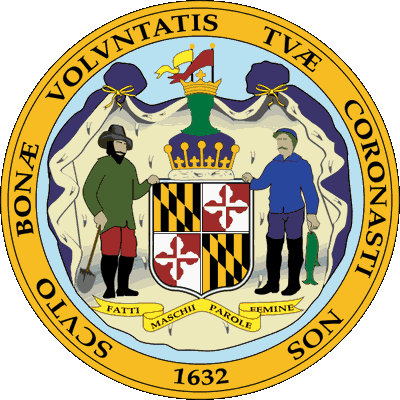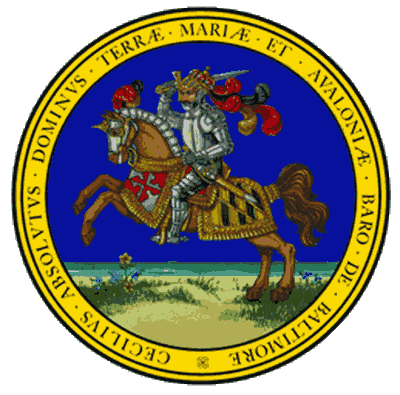- » 50 States
- » Histories
- » State Symbols
- » Seals
Maryland State Seal
Great Seal of the State of Maryland

Adopted in 1876.
The first Great Seal of Maryland was adopted in 1876. The Great Seal of Maryland is used by the Governor and the Secretary of State to authenticate Acts of the General Assembly and for other official purposes. The Secretary of State is the designated custodian of the Great Seal, and provides guidance on its use.
Only the reverse of the Great Seal is used officially. In 1959, however, the obverse was described in statute and has been considered part of the Seal (Chapter 396, Acts of 1959). Often, it adorns public buildings.
Maryland Great Seal
 The first Great Seal was brought over
during the early days of the Maryland colony, but was stolen by Richard Ingle during his rebellion of 1645. Cecilius Calvert, 2nd Lord Baltimore, sent
a similar seal from England in 1648 for the use of the Maryland Chancellor. Except for the period of crown rule (1692-1715), that Great Seal remained
in use until the end of the 18th century, the Maryland Council having authorized continued use of the provincial seal on March 31, 1777 (Constitution
of 1776, sec. 36).
The first Great Seal was brought over
during the early days of the Maryland colony, but was stolen by Richard Ingle during his rebellion of 1645. Cecilius Calvert, 2nd Lord Baltimore, sent
a similar seal from England in 1648 for the use of the Maryland Chancellor. Except for the period of crown rule (1692-1715), that Great Seal remained
in use until the end of the 18th century, the Maryland Council having authorized continued use of the provincial seal on March 31, 1777 (Constitution
of 1776, sec. 36).
A new seal with republican imagery was adopted by the Governor and Council on February 5, 1794. Designed by Charles Willson Peale, the Maryland Seal of 1794 remained in use until 1817. In that year, the General Assembly adopted a single-sided Great Seal bearing an eagle holding a shield. Another seal authorized in 1854 depicted an eagle and a version of the Calvert arms (Chapter 81, Acts of 1854).
Maryland readopted the reverse of the original Calvert seal in 1874 (Joint Resolution no. 9, Acts of 1874; Joint Resolution no. 5, Acts of 1876). This new seal corrected the imagery of the Calvert arms in the seal of 1854. It is the seal in use today. In 1959, the General Assembly adopted the seal by statute and codified its description (Chapter 396, Acts of 1959). Later revisions to the law were enacted in 1969 (Chapter 79, Acts of 1969; Code State Government Article, secs. 13-101 to 13-105).
The obverse of the Great Seal of Maryland shows Lord Baltimore as a knight in full armor mounted on a charger. The inscription translated is "Cecilius, Absolute Lord of Maryland and Avalon, Baron of Baltimore" (Chapter 79, Acts of 1969; Code State Government Article, secs. 13-101 through 13-105).
Maryland Seal Law
Article - State Government
TITLE 13. EMBLEMS; COMMEMORATIVE DAYS; MANUAL.
§13-101.
(a) The Great Seal of Maryland is the State seal.
(b) The reverse of the State seal shall be used officially. The obverse has not been used officially.
§ 13-102.
(a) On the obverse of the Great Seal of Maryland is an equestrian figure of the Lord Proprietary, arrayed in complete armour and bearing a drawn sword
in his hand. The caparisons of the horse are adorned with the family coat of arms. On the ground below is represented a sparse growth of grass on sandy
soil, with a few small blue and yellow flowers. On the circle, surrounding the obverse of the seal, is the Latin inscription "Caecilius Absolutus
Dominus Terrae Mariae et Avaloniae Baro de Baltemore", meaning "Cecil Absolute Lord of Maryland and Avalon Baron of Baltimore" (Avalon
refers to Lord Baltimore's first settlement in the new world, in Newfoundland).
(b) On the reverse of the Great Seal of Maryland is Lord Baltimore's hereditary coat of arms. The 1st and 4th quarters represent the arms of the Calvert
family described in heraldic language as a paly of 6 pieces, or (gold) and sable (black) a bend counterchanged. The 1st and 4th quarters are the left-hand
top quarter and the right-hand bottom quarter. The 2nd and 3rd quarters show the arms of the Crossland family, which Cecil inherited from his grandmother,
Alicia, wife of Leonard Calvert, the father of George, 1st Lord Baltimore. This coat of arms is in quarters also, argent (silver) and gules (red) a
cross bottony (boutonne, with a button or a three-leaf clover at the end of each radius of the cross) counterchanged. Above the shield is placed an
Earl's coronet (indicating that though only a baron in England, Calvert was an earl or count palatine in Maryland). Above that, a helmet set full faced
and over that the Calvert crest, (2 pennons, the dexter or the right one or (gold), the other sable (black) staffs gules (red) issuing from the ducal
coronet). The supporters of the shield are a plowman and a fisherman with their hands on the shield, designated respectively by a spade held in the
right hand of the plowman and a fish held in the left hand of the fisherman (the fish is heraldic and cannot, therefore, be identified as to any species).
The plowman wears a high-crowned, broad-brimmed beaver hat; the fisherman wears a knitted cap (somewhat resembling a stocking cap). The motto in Italian
on a ribbon at the feet of the plowman and fisherman is the motto of the Calvert family "Fatti maschii parole femine" loosely translated
as "Manly deeds, womanly words". Behind and surrounding both shield and supporters is an ermine-lined mantle and on the circle around this
part of the seal are the words "Scuto bonae voluntatis tuae coronasti nos" (5th Psalm, 12th verse: "With favor wilt thou compass us
as with a shield") and the date 1632. The date refers to the year the charter was granted.
§13-103.
The Secretary of State shall have custody of the State seal.
§13-104.
(a) The Governor may have the State seal:
(1) to affix it to a certified copy of a law or resolution;
(2) to affix it to a communication from the State to the United States, another state, or a foreign country; or
(3) as needed for any other purpose for which law provides.
(b) The Governor may not affix the State seal to a document or allow the State seal to be affixed to a document that the Executive Branch of the State
government issues, unless the Governor signs the document.
§13-105.
The Secretary of the Senate and the Chief Clerk of the House may have the State seal to affix it to a bill, as required by law.








